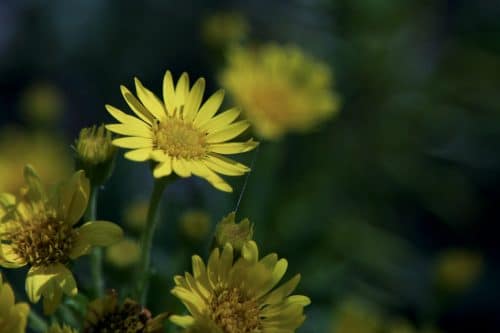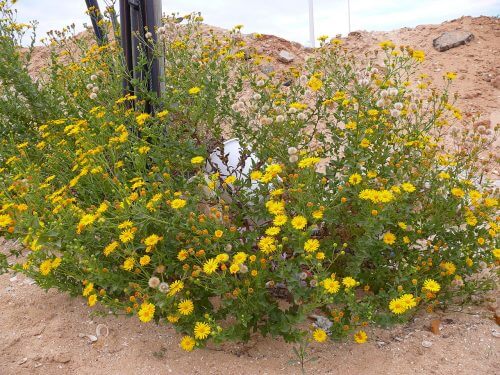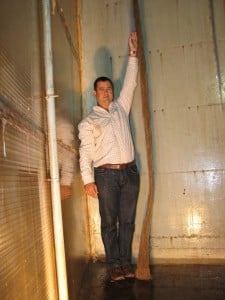Rapid evolutionary changes have caused the sand dune, an annual plant imported from the United States in the XNUMXs, to become one of the greatest biological threats to coastal plain sands

By Orlev Tsekh, Zveta, Science and Environment News Agency
Travelers to Israel's beaches during the Tishrei holidays could not help but notice the yellow blossoms that adorn the coastal strip, from Ashkelon to the shores of the Galilee. The carpets of blossoms surely delighted the travelers and vacationers, who saw the flowers as a sign of nature in all its glory.
But beneath the thicket of yellow flowers hides the story of an invasive plant, which in recent years has taken over the habitat of the dunes on the coastal plain and is driving away plants and animals that have lived there since time immemorial. New research Edited by Prof. Marcelo Sternberg from Tel Aviv University reveals the mechanism that enables the sandHeterotheca subaxillaris) to transform within four decades from a plant that helps stabilize the sands to a plant that harms the ecosystem and persistent attempts are made to exterminate it - so far, without success.
The sands will be placed very successfully, too much
The story of the sand dunes begins as a completely innocent story. The tyoninium, a plant from the mulberry family, was brought to Israel in the XNUMXs from the southeastern United States as a tool to stop the shifting sands, and a few of its seeds were sown on the Galilee coast and the Sharon coast.
At this point in the story, we should mention some characteristics of the teyon, the importance of which will be revealed later: it is an annual plant, whose flowering season in its natural habitat lasts for the three summer months, and most important of all - it has many tiny seeds, which the wind spreads efficiently. And so, while the mother spawn was growing in a nursery in Nahariya, the Tiony began to spread itself: first to the Zebulon Valley and the sands of Caesarea, in the 40s to the southern coastal plain, and today, after only about XNUMX years - to the entire coastal plain.

The tiony became one of the three main invasive species on Israel's coasts (along with the edible bluish and scarred acacia), and at this time it also turned from an annual plant, which completes its entire life cycle in one year, to a perennial plant. The tuyon has also invaded protected areas such as Nahal Polg Reserve and Nitzanim Sands, and has been observed in recent years even in the Golan, near the Bnot Ya'akov Bridge.
The problem is that the tuyon plants create very dense mats, which other plants cannot penetrate. The Tionion has positioned itself as the sole control over the sands: it competes with the local plant species and pushes them out, and is defined in the "Book of Invasive Species of Israel" as an invasive plant whose threat level is the highest. The mats of the Tiyon also threaten sand-loving animals, whose habitat the Tiyon destroys.
Over the years, various attempts have been made by the authorities to uproot and exterminate it. Excision of mature plants is not effective in the case of the tinion, because they are able to regenerate. Therefore, physical removal can only take place in the form of uprooting in the first stages of the plant's life, where the entire root can be pulled out. Spraying with herbicides is also possible, but may harm other native plants. Thus, the authorities remained powerless in the face of the Zionism, which continued to spread unhindered.
roots five meters long
The need to better understand the invasive plant put it at the center of interest of Prof. Marcelo Sternberg from the Department of Molecular Biology and Plant Ecology at Tel Aviv University. Sternberg noticed an interesting detail: the Israeli sycamore blooms in late summer and early fall, while in its homeland, which has a lot of summer rains - the southeastern United States - it blooms in the months of July-August. "The flowering stage is the most difficult stage for the plant in terms of water balance. The plant has to invest all its resources to ensure future generations," explains Prof. Sternberg. "In the research, we wanted to decipher how the Tionion succeeds in blooming at the worst time in terms of water - the end of summer in the sands."
In order to understand the transformation that the Zion went through, Prof. Sternberg had to get down to the bottom of things, literally: underground. For four years, in the laboratory for root research at Tel Aviv University, Prof. Sternberg grew seeds of sycamore from Israel and the United States. The laboratory conditions made it possible to neutralize the environmental conditions that could affect the results: the different seeds of the first generation were grown in exactly the same soil, irrigated with the same water and exposed to the same temperature, from which new seeds were collected.
Despite the equal growing conditions in the first generation, the results of the second generation were completely different: while the original species of the Zion grew roots that were one and a half meters long, as is customary in its homeland, the Israeli seeds grew roots no less than five meters long - more than three times their length (!). Another interesting result of the experiment showed that the lifespan of the local plant was almost twice that of the American source plant.

Prof. Sternberg explains the The results of the experiment In that the plant was mutated in an accelerated evolutionary process. "The Zion has undergone micro-evolution - selection processes that can take place even in a few tens of years. The deep root allows the tyonian to access the moisture and nutrients that are deep in the soil, and thus prevail over the competitors - local herbaceous plants, whose roots do not reach such depths. In this way, the tyonia manages to bloom at the most problematic time in terms of the water balance - before the first rain - and then take advantage of the arrival of the rain, which scatters the seeds, ensures their germination and makes it possible to extend the flowering period even more, because the plant receives additional water."
No place for locals
These days the sand dunes present a rare sight: a rich yellow bloom, which attracts many pollinators. But the beauty of the spectacle hides behind it its victims - many species of local plants and animals, some unique to the region, which are now in danger.
According to Prof. Sternberg, the war in Zionist is lost. But the war in Tionion is only one of the wars over the future of the sands: the intensive construction in the last 80 years damaged 70 percent of the coastal sands, and almost half of the surviving areas are threatened today by construction and development. The damage to the sands endangers not only the biological diversity, but also the coastal aquifer, for which the sands serve as a filter for the purification of rainwater.
Will we get to see the view of the sands on the seashore in a few decades? Not sure. There may be mutant plants in this story, but there is still no superhero to save the day - there is only us.
Click to read the original study HERE.

One response
It is not certain that this is a bad thing, but the local population of plants was destroyed, but the sands stopped spreading and the desertification process stopped, pollinators received more flower nectar and it may have a positive effect on the global carbon balance. The Israeli species of the sand dunes should be offered to other countries that are facing the process of desertification.